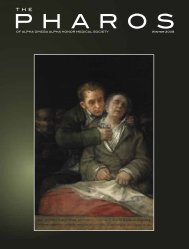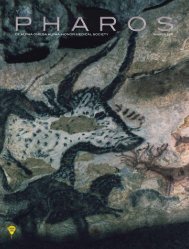The Pharos - Alpha Omega Alpha
The Pharos - Alpha Omega Alpha
The Pharos - Alpha Omega Alpha
Create successful ePaper yourself
Turn your PDF publications into a flip-book with our unique Google optimized e-Paper software.
injury to posterior branch of meningeal artery lead to temporary<br />
difficulties with an annoying hemorrhage. <strong>The</strong> vessel<br />
was definitely flattened with a spoon.<br />
Although the cutlery method of hemostasis never caught<br />
on, Cushing devised silver clips for controlling hemorrhage<br />
that became widely used. His operative note from the same<br />
1912 case documents their use: “many silver clips being necessitated<br />
owingto [sic] oozing points along the edge of the<br />
dura.” Cushing also meticulously documented blood loss, and<br />
expressed his frustration with operations muddled by vascular<br />
oozing and frank hemorrhage because this interfered with<br />
his ability to maintain the nearly bloodless operative field so<br />
strongly endorsed by Halsted.<br />
Halsted further insisted on maintaining aseptic technique<br />
in the operating theater. 6,7 In his 1904 Annual Address in<br />
Medicine at Yale University, Halsted praised the German surgical<br />
school for adopting antiseptic operative approaches, and<br />
lamented the limited foothold this theory had gained within<br />
the United States. 7 Cushing appears to have taken this lesson<br />
to heart, and documented his patients’ surgical site infections<br />
possibly to guard against future mishaps. An operative note<br />
for a second stage operation on a ten-year-old patient with a<br />
suspected brain tumor, performed without anesthesia, shows<br />
Cushing’s introspective approach to his failures in aseptic<br />
operative technique:<br />
Child in excellent condition, in spite of high temperature and<br />
rapid pulse which I had taken to be from a central disturbance<br />
rather than from any possible infection. When the dressing<br />
was removed the incision was found to be perfectly dry and<br />
beautifully healed, so much so that I commented upon it. To<br />
my intense chagrin, on opening the incision, however, there<br />
poured out what seemed to be thick creamy pus.<br />
Cushing made notes for future improvement:<br />
I had no idea . . . that it could be otherwise than an infection<br />
and it was attributed to the technical slip at operation<br />
I, namely, the withdrawal of the drainage tubes from outside<br />
in, instead of by reopening the old wound and drawing them<br />
out through the scalp and draining so as to be sure that no<br />
infection could come from the small point of skin infection<br />
above mentioned [from prior operative note].<br />
This early willingness to reflect on errors that may have led<br />
to poor results contributed to Cushing’s ability to perfect his<br />
aseptic technique in future. Within his series of transfacial<br />
approaches to lesions of the skull base, as well as transnasal<br />
approaches to the sella turcica and the pituitary gland, only<br />
rarely did surgical site infections or meningitis occur. For a<br />
surgeon operating in the pre-antibiotic era, this was certainly<br />
a hard-won achievement.<br />
Beyond operative technique, Cushing learned from Halsted<br />
the importance of integrating laboratory research into his<br />
clinical practice. In a 1904 address, Halsted gave an early description<br />
of the physician-scientist: 6<br />
After all, the hospital, the operating room and the wards<br />
should be laboratories, laboratories of the highest order, and<br />
we know from experience that where this conception prevails<br />
. . . the welfare of the patient is best promoted. . . . <strong>The</strong><br />
surgeon and the physician should be equipped and should<br />
be expected to carry on work of research. 7<br />
Cushing continued in this tradition, using cadaver models<br />
to perfect novel operative approaches. 1 A case of attempted<br />
resection of a pituitary lesion from 1910 offers a detailed analysis<br />
of the result laboratory-based cadaver experiments had on<br />
actual operations:<br />
After an experience on the cadaver the preceding day, it<br />
seemed feasible to approach the gland by an incision under<br />
the upper lip which opened into the nasal fossae and was<br />
then conducted as follows:<br />
It was a simple matter on the cadaver to remove the mucous<br />
membrane on each side of the vomer and then to insert<br />
the speculum on each side. <strong>The</strong> vomer was then removed in<br />
one piece. . . .<br />
Difficulties were encountered in the operation which had<br />
not been present on the cadaver. . . .<br />
<strong>The</strong> patient’s anterior nares proved to be so small that<br />
the same size speculum that had been used on the cadaver<br />
did not enter well and consequently the exposure of the sella<br />
tursica [sic] was less satisfactory than had been anticipated.<br />
Cushing went beyond cadaver models, bringing clinical<br />
puzzles into the laboratory to search for answers within<br />
animal models of disease. 14,15 During his year of observatorships<br />
and research in Europe, Cushing assisted Sir Charles<br />
Scott Sherrington in his laboratory exploration of the motor<br />
and sensory cortices in primate models. 1,9,16 After returning<br />
to Baltimore, Cushing brought the laboratory technique of<br />
Faradic stimulation into the operating theater for treatment<br />
of epilepsy, brain tumors, and trauma. <strong>The</strong> note accompanying<br />
the surgical treatment in 1905 of a three-year-old boy for<br />
“Epilepsy, infantile convulsions,” illustrates Cushing’s attention<br />
to detail, as well as his attempts to thoroughly map the motor<br />
cortex:<br />
It was quite easy to recognize the situation of the motor<br />
strip and efforts to obtain response by electrical stimulation<br />
met with most unaccountable results. Anywhere over<br />
the exposed part of the cortex movements of the right foot<br />
could be elicited, even with moderately slight currents.<br />
<strong>The</strong>se movements consisted of quick, sharp plantar flexion<br />
<strong>The</strong> <strong>Pharos</strong>/Autumn 2012 15














